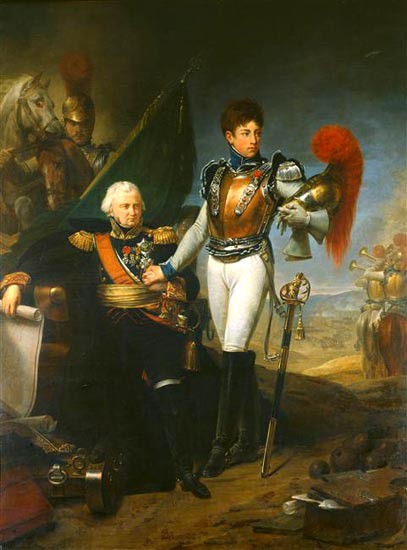During the last years of the Empire, Gros’s talent as a history painter appeared to be on the wane; it would be through his military portraits that he would rediscover the creative intensity of his earlier work, such as Bonaparte visiting the plague victims of Jaffa and Napoleon visiting the battlefield of Eylau. But whilst the portraits of General Lasalle in 1808 and that of General Fournier-Sarlovèze in 1812 displays the same flair evident in General Bonaparte on the bridge at Arcole, the double portrait of Lariboisière and his son, painted in 1814, is on an entirely different plane. The painting, which depicts the last goodbyes between General Comte de Lariboisière, Artillery Commander in the Grande Armée, and Ferdinand, Second Lieutenant in the 1er régiment de carabiniers, memorialises a father and son, both lost during the Russian campaign.
Although the painting sits squarely in a military context – Gros chooses to depict the moment the young man passes by his father’s command post, just before charging off into the Battle of the Borodino, on 7 September, 1812 – this is just a pretext for what is in actual fact a very private moment of familial attachment. The worry on the two subjects’ faces is clear to see. The way in which the father clasps his son’s hand tight to his body is deeply moving, without ever becoming overly dramatic or mawkishly sentimental. Seated on a canon support, his medals pinned to his division general uniform, Lariboisière ceases in this moment to be the artillery officer thinking of the battle ahead. The plans of attack hang limply from his right hand. He is simply a father, with his son by his side, considering the unhappy fate that lies in store for them. Standing out from the background behind them and the clear sky above, Ferdinand, looking particularly dashing in his uniform, appears less fatalistic. But the left-hand side of the painting betrays the drama that is about to unfold: a dark, foreboding sky hangs over and the young man’s white steed awaits him, clasped by a carabineer officer. The terror in the horse’s eyes mirror the horror of the combat taking place all around them. Here, as in Napoleon visiting the battlefield of Eylau, Gros uses emotion to depict the darker side of the Napoleonic legend. The young hero’s death prevails over any bravery present in the painting. Ferdinand fell during the battle, mortally wounded, while the General Lariboisière, broken, exhausted and sick, died three months later on 21 December 1812. General Lariboisière was buried in Les Invalides in 1814, where he lies in the Governors’ vault. His heart and that of his son are kept in the chapel at the Château de Monthorin in Louvigné-du-Désert (Brittany).
Karine Huguenaud and Emmanuelle Papot (tr. H.D.W.)
December 2009


